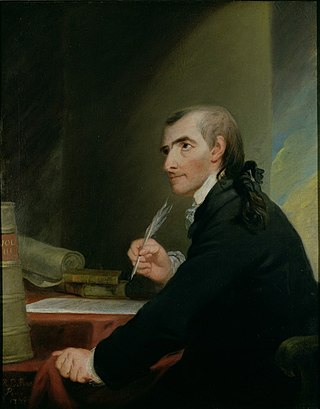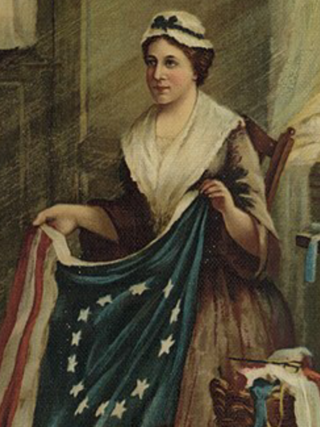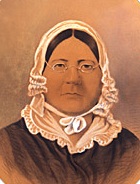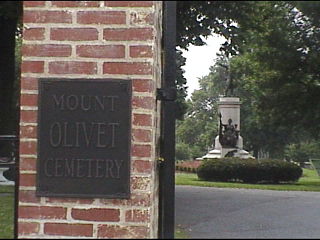Related Research Articles

Francis Scott Key was an American lawyer, author, and poet from Frederick, Maryland, best known as the author of the text of the American national anthem "The Star-Spangled Banner". Key observed the British bombardment of Fort McHenry in 1814 during the War of 1812. He was inspired upon seeing the American flag still flying over the fort at dawn and wrote the poem "Defence of Fort M'Henry"; it was published within a week with the suggested tune of the popular song "To Anacreon in Heaven". The song with Key's lyrics became known as "The Star-Spangled Banner" and slowly gained in popularity as an unofficial anthem, finally achieving official status as the national anthem more than a century later under President Herbert Hoover.

Francis Hopkinson was an American Founding Father, lawyer, jurist, author, and composer. He designed Continental paper money and two early versions of flags, one for the United States and one for the United States Navy. He was a signer of the Declaration of Independence in July 1776 as a delegate from New Jersey.

The national flag of the United States, often referred to as the American flag or the U.S. flag, consists of thirteen horizontal stripes, alternating red and white, with a blue rectangle in the canton bearing fifty small, white, five-pointed stars arranged in nine offset horizontal rows, where rows of six stars alternate with rows of five stars. The 50 stars on the flag represent the 50 U.S. states, and the 13 stripes represent the thirteen British colonies that won independence from Great Britain in the American Revolutionary War.

"The Star-Spangled Banner" is the national anthem of the United States. The lyrics come from the "Defence of Fort M'Henry", a poem written by American lawyer Francis Scott Key on September 14, 1814, after he witnessed the bombardment of Fort McHenry by the British Royal Navy during the Battle of Baltimore in the War of 1812. Key was inspired by the large U.S. flag, with 15 stars and 15 stripes, known as the Star-Spangled Banner, flying triumphantly above the fort after the battle.

Fort McHenry is a historical American coastal pentagonal bastion fort on Locust Point, now a neighborhood of Baltimore, Maryland. It is best known for its role in the War of 1812, when it successfully defended Baltimore Harbor from an attack by the British navy from Chesapeake Bay on September 13–14, 1814.

Flag Day is a holiday celebrated on June 14 in the United States. It commemorates the adoption of the flag of the United States on June 14, 1777 by resolution of the Second Continental Congress. The Flag Resolution stated "That the flag of the thirteen United States be thirteen stripes, alternate red and white; that the union be thirteen stars, white in a blue field, representing a new constellation."

Elizabeth Griscom Ross, also known by her second and third married names, Ashburn and Claypoole, was an American upholsterer who was credited by her relatives in 1870 with making the second official U.S. flag, accordingly known as the Betsy Ross flag. Though most historians dismiss the story, Ross family tradition holds that General George Washington, commander-in-chief of the Continental Army and two members of a congressional committee—Robert Morris and George Ross—visited Mrs. Ross in 1776. Mrs. Ross convinced George Washington to change the shape of the stars in a sketch of a flag he showed her from six-pointed to five-pointed by demonstrating that it was easier and speedier to cut the latter. However, there is no archival evidence or other recorded verbal tradition to substantiate this story of the first U.S. flag. It appears that the story first surfaced in the writings of her grandson in the 1870s, with no mention or documentation in earlier decades.

The Battle of Baltimore took place between British and American forces in the War of 1812. American forces repulsed sea and land invasions off the busy port city of Baltimore, Maryland, and killed the commander of the invading British forces.

The Star-Spangled Banner Flag House, formerly the Flag House & Star-Spangled Banner Museum, is a museum located in the Jonestown/Old Town and adjacent to Little Italy neighborhoods of eastern downtown Baltimore, Maryland, United States.

Mary Pickersgill was the maker of the Star-Spangled Banner hoisted over Fort McHenry during the Battle of Baltimore in the War of 1812. The daughter of another noted flag maker, Rebecca Young, Pickersgill learned her craft from her mother, and in 1813 she was commissioned by Major George Armistead to make a flag for Baltimore's Fort McHenry that was so large that the British would have no difficulty seeing it from a great distance. The flag was installed in August 1813 and, during the Battle of Baltimore a year later, Francis Scott Key could see the flag while negotiating a prisoner exchange aboard a British vessel and was inspired to pen the words that became the United States National Anthem in 1931.

The Pennsylvania Navy served as the naval force of Pennsylvania during the American Revolution and afterward, until the formation of the United States Navy. The navy's vessels served almost exclusively on the Delaware River, and were active in first defending the approaches to the city of Philadelphia during the British campaign that successfully occupied the city in 1777, and then preventing the Royal Navy from resupplying the occupying army.

Mount Olivet Cemetery is a cemetery in Frederick, Maryland. The cemetery is located at 515 South Market Street and is operated by the Mount Olivet Cemetery Company, Inc.

Pennsylvania was the site of many key events associated with the American Revolution and American Revolutionary War. The city of Philadelphia, then capital of the Thirteen Colonies and the largest city in the colonies, was a gathering place for the Founding Fathers who discussed, debated, developed, and ultimately implemented many of the acts, including signing the Declaration of Independence, that inspired and launched the revolution and the quest for independence from the British Empire.

The Betsy Ross House is a landmark in Philadelphia. It is purported to be the site where the upholsterer and flag-maker Betsy Ross (1752–1836) lived when she is said to have sewed the first American flag.

The Star-Spangled Banner, or the Great Garrison Flag, was the garrison flag that flew over Fort McHenry in Baltimore Harbor during the naval portion of the Battle of Baltimore during the War of 1812. It is on exhibit at the National Museum of American History, Smithsonian Institution. Seeing the flag flying over Fort McHenry on the morning of September 14, 1814, after the battle ended, Francis Scott Key was inspired to write the poem "Defence of Fort M'Henry". These words were written by Key and set to the tune of "To Anacreon in Heaven", a popular song at the time, by John Stafford Smith. In 1931 the song became the national anthem of the United States.
The following is a timeline of the flag of the United States.

The Betsy Ross flag is an early design for the flag of the United States, which is conformant to the Flag Act of 1777 and has red stripes outermost and stars arranged in a circle. These details elaborate on the 1777 act, passed early in the American Revolutionary War, which specified 13 alternating red and white horizontal stripes and 13 white stars in a blue canton. Its name stems from the story, once widely believed, that shortly after the 1777 act, upholsterer and flag maker Betsy Ross produced a flag of this design.

The Cowpens flag, or 3rd Maryland flag, is an early version of the United States flag that meets the congressional requirements of the Flag Resolution of 1777. Like the Betsy Ross flag, the white stars are arranged in a circle on a blue field; but the circle consists of just 12 stars, with the 13th star in the center.
Brown's Brewery was a brewery located on East Lombard Street in Baltimore, Maryland. In 1813, Mary Pickersgill sewed the famous Star Spangled Banner Flag in one of its malthouses. At the time, the brewery was owned by Baltimore merchant George I. Brown who had bought it from Edward Johnson, the third Mayor of Baltimore. George Brown sold the brewery to Eli Claggett in 1818, and until its final closure in 1879, it was known as Claggett's Brewery. The site once occupied by the brewery was excavated in 1983 as the Baltimore Center for Urban Archeology's first project.

The Dawn's Early Light is a 1972 non-fiction book by Walter Lord about the War of 1812 Battle of Baltimore and the events leading up to it. Lord said he wrote the book because of the event's significance in American history. It is one of his 13 bestsellers.
References
- Furlong, William Rea; McCandless, Byron (1981). So Proudly We Hail : The History of the United States Flag . Washington, D.C.: Smithsonian Institution Press. ISBN 0-87474-448-2.
- Leepson, Marc; DeMille, Nelson (2006). Flag: An American Biography. MacMillan. ISBN 0-312-32308-5.